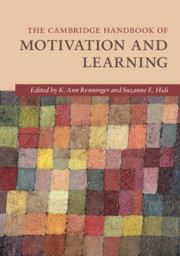Book contents
- The Cambridge Handbook of Motivation and Learning
- The Cambridge Handbook of Motivation and Learning
- Copyright page
- Epigraph
- Contents
- Figures
- Tables
- Contributors
- Foreword
- Acknowledgments
- Introduction Motivation and Its Relation to Learning
- Part I The Self and Its Impact
- Part II Rewards, Incentives, and Choice
- Part III Interest and Internal Motivation
- Part IV Curiosity and Boredom
- Part V Goals and Values
- Part VI Methods, Measures, and Perspective
- Index
- References
Part I - The Self and Its Impact
Published online by Cambridge University Press: 15 February 2019
- The Cambridge Handbook of Motivation and Learning
- The Cambridge Handbook of Motivation and Learning
- Copyright page
- Epigraph
- Contents
- Figures
- Tables
- Contributors
- Foreword
- Acknowledgments
- Introduction Motivation and Its Relation to Learning
- Part I The Self and Its Impact
- Part II Rewards, Incentives, and Choice
- Part III Interest and Internal Motivation
- Part IV Curiosity and Boredom
- Part V Goals and Values
- Part VI Methods, Measures, and Perspective
- Index
- References
Summary
In this chapter, we describe psychological and neuroscientific research that demonstrates the unique characteristics of self-related information processing. These characteristics have been shown to produce beneficial effects on basic functions (such as perception, attention, and actions), as well as on higher-order cognitive activities (including memory). The findings are explained by their correspondence to the neurocorrelates of self-related information processing. Northoff's (2016) basic model of the self, which describes self-specificity to be a fundamental aspect of the brain's spontaneous (resting) activity, provides further clarification of these results. After considering the unique characteristics of self-related information processing, we describe the potential benefits of considering findings from neuroscience for educational practice by pointing to the positive outcomes of utility value interventions. More specifically, these types of interventions, which are grounded in the expectancy-value theory of student motivation, are examples of how self-related information processing can have educational benefits by increasing motivation and learning.
- Type
- Chapter
- Information
- The Cambridge Handbook of Motivation and Learning , pp. 13 - 138Publisher: Cambridge University PressPrint publication year: 2019



